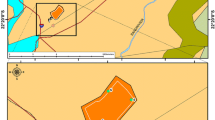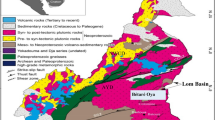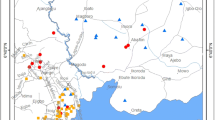Abstract
The basin of Moulouya Oued is a region where mining industry has been developed early in the 20th century. As a consequence, residues generated from past mining activities over the years have been dumped as piles of tailings. Zaïda is one of the most affected region in this basin because of lead mine exploitation for long time. The aim of this study is to determine the amount of trace elements and the contamination of the river sediments. Analysis of collected samples has been achieved using the prompt gamma activation analysis method. The samples, in form of powders, were enclosed in Teflon sheets. The spectra were analyzed using HYPERMET PC software and the chemical composition is calculated using an Excel-macro that provides the concentrations as molar and weight percentages, as well as the corresponding masses of the oxides. The validation of the analytical method is demonstrated with the analysis of a reference material. The results show that the distribution of the studied metals (Pb, Zn, Cu, Cd, Cr Ni, and As) in the basin is dependent on location with a very significant contamination by Pb, Zn, Cu, Cd, Cr, and Ni close to the lead mine sites.
Similar content being viewed by others
Explore related subjects
Discover the latest articles, news and stories from top researchers in related subjects.Avoid common mistakes on your manuscript.
Introduction
The basin of the Moulouya river is a region where mining industry has been developed early in the 20th century. As a consequence, residues generated from past mining activities over the years have been dumped as piles of tailings.
Located in the heart of high Moulouya, at about thirty kilometres to the west of Midelt’s city, Zaïda constitutes the most important lead deposit. It is the principal mine of national production after Touissit and Jbel Aouam. During time, the exploitation of this mine caused several damages on the biosphere the lithosphere and the hydrosphere.
Sediments are often considered as a site of accumulation of heavy metals in the aquatic environment and are natural reservoirs of trace elements, as it was pointed out in numerous studies [1–7].
Mining is one of the largest sources of heavy metals in the environment, and several studies have been devoted to the study of sediment contamination across the world especially by trace metals [8–19].
In Morocco, this problem can be illustrated by the Zaïda mine and other mines in the upper Moulouya (Mibladan and Aouli), which are abandoned without any rehabilitation. Several works related to this contamination of sediments were carried out [11, 20, 21].
The aim of this study is to make a diagnosis of the environmental and socioeconomic impacts of the Zaïda mining activity, and then to develop a specific methodological approach in the rehabilitation of the abandoned mine. To reach these objectives, sampling of different type of matrices was carried out (water, soil, sediments and mining rejections). The collected samples were analyzed using several analytical techniques; in this study, we will focus on the results obtained using PGAA (prompt gamma activation analysis).
Experimental
Sampling
The sampling was carried out during the period from May to June 2005, from the Moulouya Oued, its effluents and quarries mining (Fig. 1). During this period almost all the tributaries are dry. Surface sediments (5 cm thick) of the bottom of Moulouya Oued and its effluents as well as those of mining quarry lakes were sampled. They were collected using a hand drill on an area of 25 cm2, on the banks of Moulouya and mining lakes, in areas with calm sedimentation and rich fine materials. During transport, the samples were kept in clean plastic bags at low temperature in a cooler. Then, they were stored away from light and at a temperature below 4 °C to minimize bacterial activity that could alter their properties until analysis.
Elemental composition
The analysis of the major elements (Ca, Mg, K, Na, P, S, N, C, Si, and Al) and the trace elements (As, Co, Mn, Fe, V, Ti, and Sc) as well as their corresponding oxides were carried out using PGAA. The experiments were realized in the Institute of Isotopes; Hungarian Academy of Sciences, Budapest, Hungary.
The PGAA facility at the Budapest Research Reactor is located at the end of slightly curved, natural nickel coated guide of cold neutron [22]. The advantages of guided cold neutron beams are: Higher effective flux due to 1/v behaviour of the nuclide which led to higher reaction rate.
Accurate and reproducible evaluation of prompt gamma spectra is of great importance, as analytical information in derived from them. It is not infrequent that in one spectrum about one thousand peaks can be identified. So software which can handle this task is needed. HYPERMET PC [23] is a user-friendly γ-ray spectrum analysis spectrum software package developed at the Department of Nuclear Research at the Institute of Isotopes, mainly for the purpose of PGAA. The software enables an automatic fit for up to 16 K spectra taken with HPGe detectors. It contains a partial peak parameter calibration to describe peak shapes more accurately in the wide energy range.
The chemical composition is determined using the following equation:
Where: m: Mass of the element, S: Sensitivity, AE: Peak area, N A: Avogadro-number, M: Molar weight, θ: Isotopic abundance, σ0: Neutron capture cross-section, Iγ: Gamma-yield, Φ0: Neutron flux, ε(Eγ): Detector efficiency.
To determine the chemical composition, we determine the peak positions and peak intensities. The latter can be used to obtain the masses of the components using their partial gamma-ray production cross-sections. These data are taken from an analytical library prepared at Budapest [24]. If possible, the analysis is based on up to 25 peaks per element that makes possible to exclude outliers and improves the statistical uncertainties of the values. The chemical composition is calculated using an Excel-macro [22] that provides the concentrations as molar and weight percentages, as well as the corresponding masses of the oxides.
The chemical composition is determined using the method developed at Budapest. The method and its validation, has been demonstrated elsewhere [22].
Results and discussions
Geochemistry of sediments of Zaïda commune
Zaïda’s sediments, either for those of the Oueds or the lakes of mining careers, show pH values tightening all to the alkalinity (Table 1). This tendency to the alkalinity reflects the nature of sediments, dominated by the limestone and clay, in spite of the presence of mining effects.
The conductivity of these sediments shows a variation marked by an increase from the upstream to downstream of the Moulouya Oued. Furthermore, the conductivity is higher in lake sediments than in those of Oued sediments, especially in the lake C4 with a visible salinity in dry period (Salt crystals deposited by evaporation on the surface of waters).
The percentage of organic matter is significantly higher in the sediments of the lakes mining quarries than in those of the Moulouya Oued and its effluents (Table 1) which could be explained by the fact that the lakes are closed environments.
The analysis of major element contents (Table 2) shows that the sediments are mainly constituted by quartz, calcium carbonate, and different oxides and clays. Furthermore, the presence of high levels of SiO2 (61.33%) and Al2O3 (9.62%) reflects the sandy nature of the sediments. This sandy nature results from the rock of the mineralization of Pb (the arkose) and from the granite which is largely present in the Zaïda commune. The high percentage of calcium oxide ‘CaO’ (36.77%) could be attributed to limestone and marly nature of sediments that cover the studied area.
Pollution by trace elements of the Zaïda commune sediments
Sediments of the Moulouya Oued and its effluents
The analysis of different trace elements (Pb, Zn, Cu, Cr, Cd, Ni, and As) in the sediments of Moulouya Oued shows variable concentrations from a station to another, with high concentrations at the mining district, mainly in S5, S6, S14, and S20 stations (Fig. 2). Moreover, the maximum values recorded for different trace elements are lower than the values reported in the literature [25–29] except for arsenic and lead that have maximum values of 9.5 and 35 mg/kg, respectively (see Table 3).
The variation of metal concentrations from S16 station (located upstream of the mine of Moulouya Oued) to S20 station (located downstream) (Fig. 1) reflects the impact of Zaïda mine on sediments. So, the concentrations of trace elements recorded in S16 station (upstream of the mine) are lower than those recorded in S20 station (downstream of the mine), demonstrating the contamination generated and induced by the Zaïda mine on sediments of Moulouya Oued (Fig. 2).
The distribution profile of different trace elements along the studied sites shows significant enrichment from up to downstream of the mine indicating the influence of mining activities on the quality of Oued sediments.
The representation of metal concentrations (Cd, Pb, Cr, Cu, Ni, and As) versus Zn contents in Oued sediments, permits to distinguish the signature of the metal sources in the sediment of the Oued bed upstream and downstream the mine. As it is represented in Fig. 3, a good linear relationship is generally observed between Zn and other trace elements.
The high concentrations of trace elements recorded at different stations, in comparison to S16 station (situated upstream of the mine), could therefore be attributed to the impacts of Zaïda abandoned mine. It is mainly due to the effects of mining tailings, which are very rich in trace elements, and to the industrial unit related to mining activities; both of them are located on the banks of Moulouya. In fact, the tailings, without vegetation cover, are subject to the effect of intense wind and water erosion; and contribute therefore to provide the sediment by trace metals. The wastewaters coming from Zaïda village could also be considered and added to these effects because they are directly released into Moulouya Oued without any pre-treatment.
Lake sediments of mining quarries
Table 4 shows the minimum, maximum and average values of metal concentrations measured in lake sediments of the quarry mining of Zaïda commune.
A comparison with a literature [27–30] shows that the concentrations recorded in lake sediments of mining quarry of Zaïda commune are lower than those reported in the literature, except for Pb and As that indicate higher values (Table 4).
The high concentrations of trace elements recorded in mining lake sediments could be attributed to the impact of mining residues which are rich in trace elements and which probably contribute directly by water and wind erosion to the observed enrichment. Furthermore, the spatial evolution of trace element concentrations in the mining lake sediments shows that the studied metals (Pb, Zn, Cu, Cr, Cd, Ni, and As) have approximately the same profiles (Fig. 4). On the other hand, the representation of trace element contents in function of Zn concentrations (Fig. 5) shows in general a good correlation indicating that these elements have a common source in the study area. The most probable common source could be mainly attributed to the mining activities.
The trace element contents in sediments of quarry lakes are clearly higher than those recorded in the sediments of Moulouya Oued at the mining center. In fact, the remobilization and the transport of Oued sediment could cause the release and the transport of trace elements and thus a diminution of concentrations in sediments. However, for the quarry lakes, because there are considered as a closed aquatic system, an accumulation of pollutants takes place by successive additions.
So, there is a significant pollution by trace metals in sediments of Moulouya Oued and the mining lake of the Zaïda commune and they are considered as a potential reservoir of pollutants; the source of pollution is essentially mining.
Conclusion
The prompt gamma activation analysis (PGAA) gives satisfactory results with proper accuracy and reliability for determination of major elements and some trace elements and proves to be suitable for geological applications and determination of pollution in sediment samples.
The use of this technique for chemical characterization of sediments from the Moulouya Oued and mining quarry lakes of Zaïda commune permits us to quantify the concentrations of major and some trace elements. The principal obtained results show that the S16 station located upstream the Zaïda mine out of mining quarries lakes and away from any mining disturbance, has the lowest concentrations. Similarly, for S14 and S20 stations, located downstream of the Zaïda mine, the quarries have the highest concentrations indicating the direct influence of the mine and its components on the sediment quality.
This study elaborated on the sediments of the Moulouya Oued, its effluents and mining quarries lakes indicates the degree of contamination of these sediments at the level of Moulouya Oued and lakes located near the industry of mineral treatment. The distribution of trace elements highlighted the main contaminated areas.
References
Couillard D, Chartier M, Mercier G (1994) Etude de l’enlèvement du Cd, Cu, Mn et Zn par solubilisation biologique fortement contaminés. Rev des Sci de l’Eau 7:251–268
Tessier A, Campbell PGC, Bisson M (1980) Trace metal speciation in the Yamaska and St Francois Rivers (Quebec). Can J Earth Sci 17:90–105
Luoma SN (1989) Can we determine the biological availability of sediment-bound trace elements? Hydrobiologia 176(177):379–396
Wen X, Du Q, Tang H (1998) Surface complexation model for the heavy metal adsorption on natural sediment. Environ Sci Technol 32:870–875
Campbell PGC, Lewis AG, Chapman PM, Crowder AA, Feltcher NK, Imber B, Luoma SN, Stokes PM, Winfrey M (1988) Biologically available metals in sediments. NRCC 27694. National research Council of Canada, Ottawa, p 298
Shea D (1988) Developing national sediment quality criteria. Environ Sci Technol 22:1261–1656
Couillard D (1987) Qualité des sédiments en suspension et fond du système Saint-Laurent (Canada). J Hydrol Sci 32:445–467
Lee CG, Chon HT, Jung MC (2001) Heavy metal contamination in the vicinity of the Daduk Au-Ag-Pb-Zn mine in Korea. Appl Geochem J 16:1377–1386
Thomas JFA (1980) Soil contamination at Shipham-report on studies completed in the village and advice to residents. Ministry of Agriculture, Fisheries and Food, London
Matthews H (1982) The distribution of cadmium and associated elements in the soil-plant system at sites in Britain contaminated by mining, smelting and metal-rich bedrock. PhD Thesis. University of London
Saidi N (2004) Le bassin versant de la Moulouya: pollution par les métaux lourds et essais de phytoremédiation. PhD Thesis. Faculty of Sciences, University Mohamed V, Rabat, Morocco
Thornton I (1980) Geochemical aspects of heavy metal pollution and agriculture in England and Wales. Reference Book, Ministry of Agriculture, Fisheries and Food No. 326 pp 105–125
Li X, Thornton I (1993) Multi-element contamination of soils and plants in old mining areas, U.K. Appl Geochem (suppl no. 2):51–56
Jung MC, Thornton I (1996) Heavy metal contamination of soils and plants in the vicinity of a lead-zinc mine, Korea. Appl Geochem 11:53–59
Benisse R, Labat M, El Asli A, Bahada F, Qatibi A (2004) Rhizosphere bacterial populations of metallophyte plants in heavy metal-contaminated soils from mining areas in semiarid climate. World J Microbiol Biotechnol 20:759–766
Ye ZH, Baker AJM, Willis AJ (1997) Zinc, lead and cadmium tolerance, uptake and accumulation by Typha latifolia. New Phytol 136:469–480
Fuge R, Pearce FM, Pearce NJG, Perkins WT (1993) Geochemistry of Cd in the secondary environment near abandoned metalliferous mines. Appl Geochem 2:29–35
Dudka S, Piotrowska M, Chlopeckca A, Witek T (1995) Trace metal contamination of soils and crops plants by the mining and industry in Upper Silesia, south Poland. J Geochem Explor 5:237–250
Jung MC (2001) Heavy metal contamination of soils and waters in and around the Imcheon Au–Ag mine, Korea. Appl Geochem 16:1369–1375
Bouabdli A, Saidi N, El Founti L, Leblanc M (2004) Impact de la mine d’Aouli sur les eaux et les sédiments de l’Oued Moulouya (Maroc). Bull de la Société D’hist Naturelle de Toulouse 140:27–33
El Hachimi M (2007) Les districts miniers Aouali-Mibladen-Zaïda, abandonnés dans la Haute Moulouya (Maroc). Ph D Thesis. Faculty of Sciences, University Ibn Tofaïl, Kenitra
Zs Révay (2009) Determining elemental composition using prompt γ activation analysis. Anal Chem 81:6851–6859
Révay Zs, Belgya T, Ember PP, Molnár GL (2001) Recent developments in HYP ERMET PC. J Radioanal Nucl Chem 248(2):401–405
Révay Zs, Firestone RB, Belgya T, Molnár GL (2004) Handbook of prompt gamma activation analysis with neutron beams. Kluwer Academic Publishers, Dordrecht, pp 173–366
Bowen HJM (1979) Environmental chemistry of elements. Academic Press, New York, pp 49–62
Smedley PL, Kinniburgh DG (2002) A review of the source, behaviour and distribution of arsenic in natural waters. Appl Geochem 17:517–568
HSDB (2003) National library of medicine. htpp://www.toxnet.nlm.nih.gov
CE (1999) Risk assessment for zinc metal. Part 2: human health. European Commission, Brussels
CE (2000) European Union, RB26005 env
Molénat N, Holeman M, Pinel R (2000) L’arsenic, polluant de l’environnement: origine, distribution, biotransformation. L’Actual Chim 232:12–23
Boust D (1981) Métaux traces dans l’estuaire de la seine et ses abords. Thèse de 3ème cycle. Caen University, Caen, p 187
Author information
Authors and Affiliations
Corresponding author
Rights and permissions
About this article
Cite this article
Bounakhla, M., Embarch, K., Tahri, M. et al. PGAA metals analysis in tailings in Zaida abandoned mine, high Moulouya, Morocco. J Radioanal Nucl Chem 291, 129–135 (2012). https://doi.org/10.1007/s10967-011-1321-6
Received:
Published:
Issue Date:
DOI: https://doi.org/10.1007/s10967-011-1321-6









